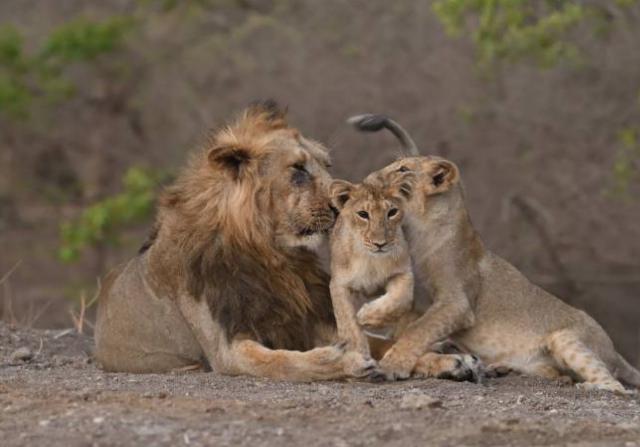Asiatic lions in Gujarat are weak and may be getting weaker with time. Inbreeding is causing several genetic disorders. Their vigor and vitality are declining. An interesting and elaborate research on the population of Asiatic lions has also shown “missing and malformed limbs” among lion cubs in Saurashtra Landscape in Gujarat, the only home to lions in India. “The lion has become a socio-political instrument in Gujarat, which despite a Supreme Court directive has not parted with founders to establish another population. Threats from epidemics loom large and currently a canine distemper virus outbreak is prevalent”, the study has warned.
Inbreeding Effects On Vigor
Also read: Lion ,Cheetah And The Politics Of Conservation
The report “ Asiatic Lion: Ecology, Economics, and Politics of Conservation” published in 2019 has dwelt in detail the effects of inbreeding among the big cats. The report is an outcome of an excellent research work of eminent scientists from the Wildlife Institute of India (WII). Headed by Yadvendradev V. Jhala, dean WII, the other researchers include Kausik Banerjee, Stotra Chakrabarti , Parabita Basu,Kartikeya Singh, Chittaranjan Dave, and Keshab Gogoi. Amidst Cheetah introduction in Kuno Palpur National park (KPNP) in Madhya Pradesh, Lions have been in news again these days as Kuno was originally prepared for lion translocation. But two decades of preparation, a long legal battle and a favourable Supreme Court order for lion translocation were not enough for the big cat to reach their new home. The report prepared by Jhala and his colleagues had opined , “Establishing a second free-ranging lion population away from Gir should be the most important conservation priority for the species. Kuno is an ideal option in a state that has a proven track record for tiger conservation”. The report said,“ Todd (1965) attributed dentition abnormalities in Asiatic lions to inbreeding. ” Decreased heterozygosity likely diminishes reproductive vigor and long-term survival of a population”, the report warned. Loss of heterozygosity is a type of genetic abnormality. The scientists did not stop here.
Human , Diseases Cause High Percentage Of Deaths
Discussing the mortality among the lions, the report said that the human caused mortality was very high. It said, “Based on records of 22 lion mortalities recorded between 2007 and 2019, we estimated that 30% of the deaths were caused by diseases”. It further said “ Adult lions died primarily due to natural causes (60%), however, human caused mortality was also substantial (32%). Deaths due to falling in open irrigation wells, electrocution by live wires deployed illegally to prevent crop damage from nilgai (Boselaphus tragocamelus) and wild pigs (Sus scrofa) were a cause of concern in the agro-pastoral landscape. These are being addressed by wildlife authorities by subsidizing the construction of parapets around open wells and pulsating solar-powered wildlife fences to agricultural fields. ” Remember the statement given by the Gujarat government in March this year.
Also read: Cheetah Races For Kuno, Defeats Lion
The state government had informed the Assembly that 313 Asiatic lions had died in the preceding two years. Of these, 154 were reported in 2019 and 159 in 2020. Taken together with the 124 deaths reported in 2021, a total of 437 lion deaths have been officially reported from the state — home to the world’s only population of wild lions outside Africa. The government stated there were 674 lions living in the wild, in and around the Gir Sanctuary in the state, as of December 31, 2021. This includes 206 males, 309 females and 29 cubs. Of these, 345 lions were inside Gir Sanctuary, while 329 lions, or almost half of the total population, were outside the sanctuary.
“Too Much Intervention May Have Serious Implications”
The report also revealed that, “ there have been recorded instances where free-ranging lion cubs were detected with missing and malformed limbs, or were born blind .These are potential indicators of inbreeding , and in nature such handicapped individuals rarely survive to propagate these traits, thereby purging out deleterious alleles (one of two or more versions of DNA sequence) from the population over time”. Jhala, a veteran scientist who is involved actively in Cheetah translocation in Kuno national park, has also warned of the “serious implications on future survival of lions”.
Also read: Lion Spillover From Gir National Park Gets Closer To Ahmedabad
His report said, “ Intensive health care of wild lions as practiced in recent times by wildlife managers between 2001 and 2010, as many as 501 lions were captured and treated by Gujarat Forest Department to ensure survival of many such unfit individuals. “ Such tampering with natural selection processes can have serious implications on the future survival of wild lions”, the report warns. Movement of lions was recorded in a 22,000-square-kilometre area of Saurashtra. Lions have now established their permanent territories in Junagadh, Gir Somnath, Amreli and Bhavnagar districts in the Saurashtra region. They often visit adjoining districts such as Rajkot and Porbandar. Presence of lions was also recorded in Ahmedabad district- all this in one part of the state. We have already seen the ill- efects of inbreeding among the tigers in certains parts of India where tiger coat is changing colours.
Representational Pictures: tourmyindia.com and Gir national park





